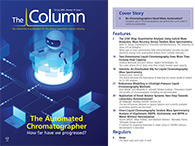The LCGC Blog: Quantitative Analysis Using Hybrid Mass Analyzers: Mass Accuracy Versus Tandem Mass Spectrometry
What type of mass spectrometry (MS) instrumentation provides the best specificity during trace quantitative analysis from complex mixtures?
Photo Credit: nexusby/Shutterstock.com

What type of mass spectrometry (MS) instrumentation provides the best specificity during trace quantitative analysis from complex mixtures?
It’s a debate that has been going on for some time. I would have to speculate it is an argument that was initially propagated by a purveyor of one technology provider over other. The overarching issue is what type of mass spectrometry (MS) instrumentation provides the best specificity during trace quantitative analysis from complex mixtures. Electrospray ionization (ESI), being the most common ionization source for liquid-phase sampling into MS, is a very efficient means for producing gas phase ions; as such, complex mixtures will yield a plethora of signals, and those signals for the analytes of interest must be reliably differentiated from those from potential interferences. Obviously, MS provides strong qualitative information in the form of mass-to-charge ratios (m/z) to aid compound identification, but in a complex mixture there can be a large number of species with very similar or identical masses.
If you want to differentiate target analytes from interferences, is it better to have an instrument that provides high resolution and high mass accuracy, or one that offers tandem mass spectrometry (MS/MS)? Let’s start where the mainstream debate started-comparing the highâresolution mass spectrometry (HRMS) capabilities of an orbital trap mass analyzer versus the MS/MS capabilities of a triple-quadrupole (QQQ) mass analyzer. Which provides better specificity? Let’s also put sensitivity aside, because nowadays modern ESI-MS instruments can all generally detect very low abundance species.
QQQ-MS has long been referred to as the gold standard for quantitative analysis. When operated in selected reaction monitoring (SRM) (or multiple reaction monitoring [MRM]) mode, a QQQ-MS system provides specificity through first isolating a mass of interest and then generating a unique diagnostic highâabundance fragment ion from that analyte of interest by collision-induced dissociation (CID). By focusing on a specific fragment of an ion, virtually all isobaric interferences in a sample will be excluded from detection, because only the analyte of interest should yield that fragment after it is dissociated. A wide linear range is inherent to quadrupole instruments, relative to other mass analyzers, and many modern QQQ-MS instruments have very high scan speeds. This wide linear range and high scan speed enable the instruments to monitor many-even hundreds or thousands-of specific precursor to product ion MRM transitions in a single run. QQQ-MS instruments are also relatively affordable, and they are widely distributed through routine analytical laboratories, primarily for the purpose of carrying out quantitative analysis. The biggest drawback is that QQQ-MS systems are low, unit-resolution instruments, so only integer m/z values can generally be reliably assigned to detected ions.
The orbital trap, released commercially 13 years ago, operates on a different principle. Ions are made to orbit a spindle electrode in the high-vacuum region of the instrument. As they orbit this spindle, they are separated from other ions having different m/z values with extremely high resolution. The frequency of ion movement is measured, and then a Fourier transform is applied to convert this information into mass spectra. As a result, ions that reach the detector can be assigned very accurate m/z values, down to four or five decimal places. With sub-parts-per-million error in mass accuracy, the number of ways that you can put together multiple carbon, oxygen, nitrogen, and other atoms to generate a specific molecular formula decreases dramatically. Thus, high specificity is achieved by ensuring that molecular formula of the ion detected well matches that of the target analyte ion. Yet, high resolution comes at a cost. Orbital mass analyzers are generally much more expensive than QQQ-MS systems, and they are also relatively slower. Trap instruments are also characterized as having reduced linear operating ranges compared to quadrupole instruments. Even so, most versions of commercial orbital trap instruments also incorporate the capability for tandem mass analysis, which broadens their application base considerably. Fourier transform ion cyclotron resonance mass spectrometry (FT-ICR-MS) systems can be characterized similarly. However, without some capability to fragment ions, no amount of resolution can resolve isobaric species.
A quick search will show that some significant work has been performed previously to directly compare MS/MS with HRMS for quantitative performance. In many cases, comparable performance can be claimed (1), but performance is also dependent on the nature of the analyte and sample in question-I think one could always find applications where one or the other approach wins out. One study determined that a single m/z measured by HRMS at >50,000 resolution is more selective than performing SRM on a QQQ-MS system (2). With such a report, one might consider this debate case closed in favour of HRMS, but cost is still an important driver in most people’s purchasing decisions. As a result, the market for QQQ-MS instruments is still quite a bit larger than for HRMS systems.
The truth is, ideally you would like to have both capabilities. Nowadays, with continued and growing interest in the vast array of “omics” topics, researchers would like to combine both targeted and untargeted data collection capabilities. A targeted method is one for which you know what you are looking, whereas an untargeted method is designed to collect signals for anything that might be in a sample. In that case, it is reasonable to argue that a quadrupole time-of-flight (QTOF) mass spectrometer provides the best compromise between the need for HRMS and MS/MS.
In a QTOF system, a fast scanning quadrupole can be interfaced, through a CID cell, with a TOF mass analyzer. TOF measures a flight time to determine m/z values, and this can be done with quite good resolution and mass accuracy. Flightâtime measurements are a bit less accurate than ion frequency measurements, but the former are much simpler and less expensive to perform than the latter. QTOF systems maintain a wide linear range, are fast, and provide for MS and MS/MS measurements with standard resolutions in the 30,000–50,000 range. Although QTOF systems can be quite versatile and powerful, a common issue with TOF systems is the stability of their calibration. Often small changes in temperature over time can cause significant drift in mass accuracy. Either the temperature of the laboratory needs to be carefully maintained, or the TOF system needs to be calibrated often. In many cases, calibration mixtures for tuning TOF flight times can be quite sticky, making them difficult to clean from the system after use. A stable QTOF, which does not have to be calibrated often, is certainly a desirable item.
One thing is for sure-there are a lot of choices out there in the mass spectrometer marketplace. It is extremely important to assess the planned primary use of the system to make the correct choice. You can never have too much resolution, but it comes at a cost (both analysis time and money). I would also be remiss if I didn’t mention the critical role of the sample preparation and chromatographic systems that often come before the mass spectrometer. If sample collection, preparation, and separation are done poorly, no mass spectrometer will provide good quality data, no matter how much money you spend.
References
- E.I. Hamelin, W. Bragg, R.L. Shaner, L.L. Swaim, and R.C. Johnson, Rapid Commun. Mass Spectrom. 27, 1697–1704 (2013).
- A. Kaufmann, P. Butcher, K. Maden, S. Walker, and M. Widmer, Anal. Chim. Acta673, 60–72 (2010).
Kevin A. Schug is a Full Professor and Shimadzu Distinguished Professor of Analytical Chemistry in the Department of Chemistry & Biochemistry at The University of Texas (UT) at Arlington. He joined the faculty at UT Arlington in 2005 after completing a Ph.D. in Chemistry at Virginia Tech under the direction of Prof. Harold M. McNair and a post-doctoral fellowship at the University of Vienna under Prof. Wolfgang Lindner. Research in the Schug group spans fundamental and applied areas of separation science and mass spectrometry. Schug was named the LCGCEmerging Leader in Chromatography in 2009 and the 2012 American Chemical Society Division of Analytical Chemistry Young Investigator in Separation Science. He is a fellow of both the U.T. Arlington and U.T. System-Wide Academies of Distinguished Teachers.
E-mail:kschug@uta.eduWebsite:www.chromatographyonline.com

This information is supplementary to the article “Accelerating Monoclonal Antibody Quality Control: The Role of LC–MS in Upstream Bioprocessing”, which was published in the May 2025 issue of Current Trends in Mass Spectrometry.
Investigating the Protective Effects of Frankincense Oil on Wound Healing with GC–MS
April 2nd 2025Frankincense essential oil is known for its anti-inflammatory, antioxidant, and therapeutic properties. A recent study investigated the protective effects of the oil in an excision wound model in rats, focusing on oxidative stress reduction, inflammatory cytokine modulation, and caspase-3 regulation; chemical composition of the oil was analyzed using gas chromatography–mass spectrometry (GC–MS).













